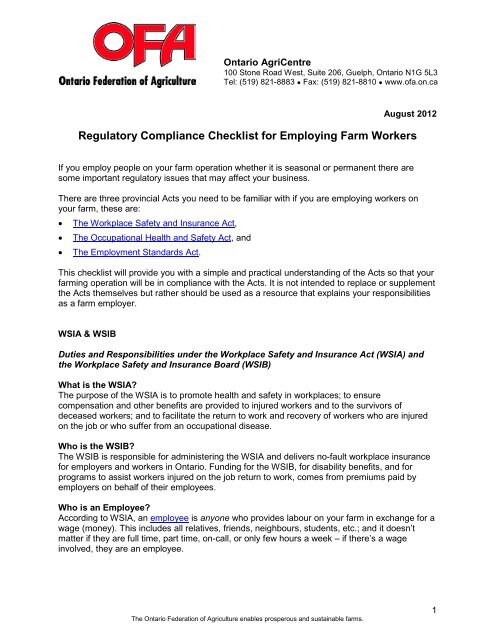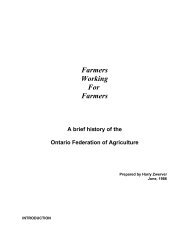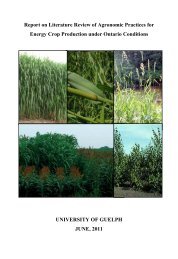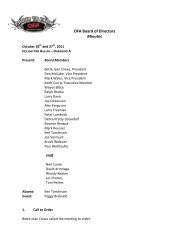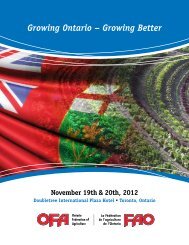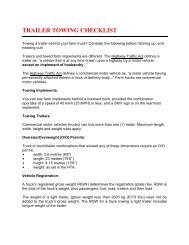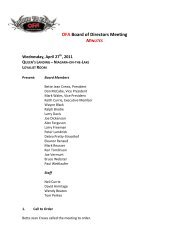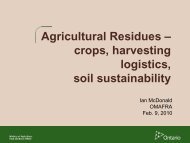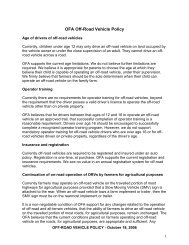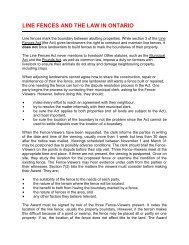Regulatory Compliance Checklist for Employing Farm Workers
Regulatory Compliance Checklist for Employing Farm Workers
Regulatory Compliance Checklist for Employing Farm Workers
You also want an ePaper? Increase the reach of your titles
YUMPU automatically turns print PDFs into web optimized ePapers that Google loves.
Ontario AgriCentre<br />
100 Stone Road West, Suite 206, Guelph, Ontario N1G 5L3<br />
Tel: (519) 821-8883 ● Fax: (519) 821-8810 ● www.ofa.on.ca<br />
August 2012<br />
<strong>Regulatory</strong> <strong>Compliance</strong> <strong>Checklist</strong> <strong>for</strong> <strong>Employing</strong> <strong>Farm</strong> <strong>Workers</strong><br />
If you employ people on your farm operation whether it is seasonal or permanent there are<br />
some important regulatory issues that may affect your business.<br />
There are three provincial Acts you need to be familiar with if you are employing workers on<br />
your farm, these are:<br />
• The Workplace Safety and Insurance Act,<br />
• The Occupational Health and Safety Act, and<br />
• The Employment Standards Act.<br />
This checklist will provide you with a simple and practical understanding of the Acts so that your<br />
farming operation will be in compliance with the Acts. It is not intended to replace or supplement<br />
the Acts themselves but rather should be used as a resource that explains your responsibilities<br />
as a farm employer.<br />
WSIA & WSIB<br />
Duties and Responsibilities under the Workplace Safety and Insurance Act (WSIA) and<br />
the Workplace Safety and Insurance Board (WSIB)<br />
What is the WSIA?<br />
The purpose of the WSIA is to promote health and safety in workplaces; to ensure<br />
compensation and other benefits are provided to injured workers and to the survivors of<br />
deceased workers; and to facilitate the return to work and recovery of workers who are injured<br />
on the job or who suffer from an occupational disease.<br />
Who is the WSIB?<br />
The WSIB is responsible <strong>for</strong> administering the WSIA and delivers no-fault workplace insurance<br />
<strong>for</strong> employers and workers in Ontario. Funding <strong>for</strong> the WSIB, <strong>for</strong> disability benefits, and <strong>for</strong><br />
programs to assist workers injured on the job return to work, comes from premiums paid by<br />
employers on behalf of their employees.<br />
Who is an Employee?<br />
According to WSIA, an employee is anyone who provides labour on your farm in exchange <strong>for</strong> a<br />
wage (money). This includes all relatives, friends, neighbours, students, etc.; and it doesn’t<br />
matter if they are full time, part time, on-call, or only few hours a week – if there’s a wage<br />
involved, they are an employee.<br />
The Ontario Federation of Agriculture enables prosperous and sustainable farms.<br />
1
Custom Work and Contractors<br />
If you are planning on hiring a custom operator to work on your farm, you must provide proof to<br />
the WSIB – even if you are not a client – that the operator is independent of your farm so that<br />
you will not be responsible <strong>for</strong> their insurance premiums. For more in<strong>for</strong>mation on this, refer to<br />
Custom <strong>Farm</strong> Work Fact sheet, and call WSIB. Another option is to use the new internet-based<br />
eClearance system available through the WSIB website.<br />
Getting Started<br />
The WSIB has a number of Factsheets available on their website to help get you started. Please<br />
refer to the factsheet: System Overview <strong>for</strong> Employers.<br />
<strong>Compliance</strong><br />
Agricultural employers are required to provide coverage to their employees through the WSIB.<br />
No other coverage is acceptable <strong>for</strong> an employee. The WSIB requires that you register your<br />
new employee within 10 days of their first day of work. Also, if your employee is injured at work<br />
or gets sick as a result of their job, you must report it using a Form 7 to the WSIB within three<br />
days of learning about it. This is the law.<br />
The law also requires employers provide workers with a first aid box on the farm. It needs to be<br />
easily accessible and fully stocked with specific items. Regulation 1101 details what items need<br />
to be in the box, as well as the inspection, documentation, and training requirements <strong>for</strong> first aid.<br />
Consequences<br />
<strong>Farm</strong> employers who do not register employees with the WSIB can face significant financial and<br />
legal penalties if they are discovered during WSIB audits and investigations. You should know<br />
that the WSIB has an in<strong>for</strong>mation sharing agreement with the Canada Revenue Agency (CRA)<br />
to facilitate these investigations.<br />
Required Workplace Postings<br />
WSIB regulations require one poster to be displayed in a noticeable place on the farm. The<br />
most likely place is a farm office, though an equipment shed, or workshop where your employee<br />
will see it is also acceptable:<br />
• Form 82 – 1234 In Case of Injury at Work Poster<br />
<strong>Compliance</strong> <strong>Checklist</strong><br />
I have contacted WSIB and registered my employee(s);<br />
I have paid the WSIB insurance premiums <strong>for</strong> my employee(s);<br />
I have printed and posted Form 82 – 1234 In Case of Injury at Work Poster<br />
I have a first aid box on the farm<br />
It is stocked with the required items and easily accessible<br />
My employee(s) knows where the first aid box is located<br />
For More In<strong>for</strong>mation:<br />
WSIB has an agriculture sector office located in Guelph. To set up an account and register your<br />
new employee, or inquire about clearance certificates, contact:<br />
Phone: 519-826-4650 or 1-888-259-4228<br />
Fax: 519-826-4678<br />
WSIB’s Clearance Department at 1-800-387-8638<br />
100 Stone Road West, 2nd floor, Guelph, ON N1G 5L3<br />
____________________________________________________________________________<br />
The Ontario Federation of Agriculture enables prosperous and sustainable farms.<br />
2
MINISTRY OF LABOUR<br />
Duties and Responsibilities under the Occupational Health and Safety Act (OHSA)<br />
What is the OHSA?<br />
OSHA is the key piece of legislation in Ontario governing workplace health and safety. The Act<br />
is based on the Internal Responsibility System (IRS) and is meant to share responsibility<br />
between employers and workers in creating a safe workplace with healthy workers. It sets out a<br />
number of rights and duties <strong>for</strong> employers and workers and establishes a process <strong>for</strong> en<strong>for</strong>cing<br />
the Act where there is non-compliance. For most cases in agriculture, the workplace is<br />
considered to be the farm property, excluding any personal residences.<br />
Getting Started<br />
An important document that new and existing farm employers should have on hand is the<br />
“Guide to the Occupational Health and Safety Act <strong>for</strong> <strong>Farm</strong>ing Operations”.<br />
<strong>Compliance</strong><br />
All farm operations with one or more paid employees are covered under OSHA. It is important to<br />
know that this applies whenever one of your employees is present in the workplace, no matter<br />
how short that time might be.<br />
While there are few substantial requirements <strong>for</strong> farm operations under OSHA, a critical<br />
provision in the Act dictates that employers must “take every precaution reasonable in the<br />
circumstances <strong>for</strong> the protection of a worker”.<br />
To achieve this goal, the legislation requires farm employers to provide workers with:<br />
• In<strong>for</strong>mation on workplace hazards and toxic substances;<br />
• Instruction and supervision <strong>for</strong> farm equipment or hazardous locations;<br />
• An opportunity to identify and resolve health and safety concerns; and<br />
• The right to refuse work that they believe is dangerous without fear of employer reprisal.<br />
Also, it’s important to know that OHSA requires an employer to immediately notify the Ministry of<br />
Labour if a worker is fatally or critically injured in the farm.<br />
Consequences<br />
The Act and its regulations are en<strong>for</strong>ced by Health and Safety Inspectors at the Ministry of<br />
Labour (MOL). Their role is to both inspect workplaces to check <strong>for</strong> compliance with the Act, and<br />
investigate workplace incidents, complaints, and work refusals. MOL inspectors most often visit<br />
workplaces in response to complaints or reports of injuries; however, they will also conduct<br />
random inspections and focused blitzes.<br />
If you are found to be in non-compliance, MOL Inspectors can:<br />
• Write compliance orders that carry specific legal requirements;<br />
• Issue “stop work” orders if there is an immediate risk that a worker could be injured;<br />
• Issue tickets or initiate prosecution where a worker has been injured as a result of noncompliance<br />
The Ontario Federation of Agriculture enables prosperous and sustainable farms.<br />
3
Required Workplace Postings and Documents<br />
OSHA requires a few postings and documents to be completed by employers:<br />
• A copy of the Occupational Health and Safety Act must be posted in a prominent place –<br />
ideally where you have placed your other postings – or have it be available at the workplace.<br />
• As of October 1 st , 2012, all Ontario workplaces must also post the “Health & Safety at Work -<br />
Prevention Starts Here” poster. The poster is available in 17 different languages on the<br />
Ministry of Labour website.<br />
• Every employer in Ontario, regardless of the size of the operation or the number of workers,<br />
must prepare and review a policy on Workplace Violence and Harassment. A plain<br />
language guide, “Workplace Violence and Harassment: Understanding the Law”, is available<br />
from the Ministry of Labour and provides policy templates <strong>for</strong> employers in the appendices.<br />
• If you have six or more regularly employed workers, you must prepare and post a written<br />
and signed Health and Safety policy, and must develop and maintain a program to<br />
implement that policy. Even if you have less than 6 employees, it is generally<br />
recommended that you complete a Health and Safety Polcy <strong>for</strong> your farm.<br />
• If a workplace report is given to you by an MOL inspector, it must be posted as well.<br />
<strong>Compliance</strong> <strong>Checklist</strong><br />
I have fewer than 6 employees:<br />
I have posted a copy of the Occupational Health and Safety Act<br />
I have posted the “Health & Safety at Work – Prevention Starts Here” poster<br />
I have prepared a Violence and Harassment Policy <strong>for</strong> the farm, and I have in<strong>for</strong>med my<br />
employees of the policy<br />
I am aware that should a worker or individual be fatally or critically injured on the farm,<br />
OHSA requires an employer to immediately notify the Ministry of Labour.<br />
I have 6 or more employees:<br />
I have posted a copy of the Occupational Health and Safety Act<br />
I have posted the “Health & Safety at Work – Prevention Starts Here” poster<br />
I have posted a written Health and Safety policy<br />
I have posted a written Violence and Harassment Policy <strong>for</strong> the farm and have a program to<br />
implement it.<br />
I have 6 to 19 regularly employed workers, and they have selected a co-worker as their<br />
Health and Safety Representative<br />
I have posted the name of the employee acting as the Health and Safety Representative in<br />
the workplace<br />
I am aware that should a worker or individual be fatally or critically injured on the farm,<br />
OHSA requires an employer to immediately notify the Ministry of Labour.<br />
For More In<strong>for</strong>mation<br />
Ministry of Labour Health and Safety Contact Centre<br />
Phone: 1-877-202-0008<br />
Website: www.labour.gov.on.ca/english/hs/<br />
Regional Offices: www.labour.gov.on.ca/english/about/reg_offices.php<br />
____________________________________________________________________________<br />
The Ontario Federation of Agriculture enables prosperous and sustainable farms.<br />
4
Employer Responsibilities under the Employment Standards Act, 2000 (ESA)<br />
What is the ESA?<br />
The ESA provides the minimum rights and responsibilities of most employees and employers in<br />
Ontario workplaces. It covers a number of employment standards, including the payment of<br />
wages, hours of work, and termination of employment. Like WSIB premium rate groups, there<br />
are different categories of agricultural workers covered by the ESA, each with their own set of<br />
exemptions or special rules.<br />
Getting Started<br />
The Ministry of Labour publishes two guides to help employers understand their responsibilities<br />
under the ESA. While not specific to farming, the publications, Your Guide to the Employment<br />
Standards Act, 2000, and Complying with the Employment Standards Act (ESA): A Workbook<br />
<strong>for</strong> Employers provide the necessary in<strong>for</strong>mation <strong>for</strong> your workplace.<br />
<strong>Compliance</strong><br />
There are three major ESA categories that farm employers may hire under: <strong>Farm</strong> Employees;<br />
“<strong>Farm</strong> Related Exemptions”; and Harvesters of Fruit, Vegetables and Tobacco. As mentioned<br />
above, each of these categories carries various exemptions and special rules. Most small farms<br />
will hire under the ‘farm employees’ category, but it’s important to refer to the guide to determine<br />
which category your employee best fits and make sure you understand the minimum standards.<br />
If you are planning on hiring a student to work on your farm during the summer break, it is<br />
important to note that there are special rules and exemptions <strong>for</strong> student employees. The<br />
“student employee” category would only apply on your farm if you are hiring the student <strong>for</strong> work<br />
not related to primary production. If the student is working in primary production on the farm,<br />
they will be considered a ‘farm employee’ – basically there’s no special category <strong>for</strong> “student<br />
farm labour”.<br />
Regardless of the ESA job category, all farm employers in Ontario must:<br />
• Keep written records of each employee’s name, address, and employment starting date;<br />
• Establish a regular pay period and a regular payday <strong>for</strong> employees;<br />
• Provide an employee with a wage statement;<br />
• Provide an employee with either written notice of termination, termination pay or a<br />
combination of both when a worker has been employed continuously <strong>for</strong> more than three<br />
months<br />
• Provide an employee with job-protected, statutory leaves of absences<br />
• Provide a qualified employee with severance pay who has his or her employment “severed.<br />
Consequences<br />
The Act gives the Ministry of Labour the power to investigate infractions and en<strong>for</strong>ce the ESA.<br />
The majority of ESA investigations are the result of claims filed by an employee; however<br />
Employment Standards Officers also conduct proactive inspections. Officers have the power to<br />
issue orders to pay wages, compliance orders or tickets, notices of contravention, or initiate<br />
prosecution in severe cases of non-compliance.<br />
The Ontario Federation of Agriculture enables prosperous and sustainable farms.<br />
5
Required Workplace Postings and Documents<br />
The ESA requires that employers in Ontario post the What You Should Know About the Ontario<br />
Employment Standards Act poster in a prominent place, likely where you have posted WSIB<br />
and OHSA documents. Printing the poster in a regular legal size (8½” x 14”) sheet is<br />
acceptable.<br />
<strong>Compliance</strong> <strong>Checklist</strong><br />
I have posted the required What You Should Know About the Ontario Employment<br />
Standards Act poster<br />
I have collected the necessary in<strong>for</strong>mation from my employee to document their employment<br />
I have established a regular pay period and pay records <strong>for</strong> my employee<br />
For More In<strong>for</strong>mation<br />
Employment Standards In<strong>for</strong>mation Centre<br />
Phone: 1-800-531-5551<br />
Website: www.labour.gov.on.ca/english/es/<br />
____________________________________________________________________________<br />
Key Employer Resources<br />
Workplace Safety and Insurance Board (WSIB)<br />
• Custom <strong>Farm</strong> Work<br />
• First Aid Requirements Factsheet<br />
• Reporting workplace injuries and illnesses<br />
• Reporting earnings <strong>for</strong> workers with irregular hours/work days<br />
Occupational Health and Safety Act (OHSA)<br />
• Occupational Health and Safety Guidelines <strong>for</strong> <strong>Farm</strong>ing Operations in Ontario<br />
• Developing Workplace Violence and Harassment Policies and Programs:<br />
• What Employers Need to Know<br />
• A Toolbox<br />
• Workplace Safety and Prevention Services – A Health and Safety Ontario Partner<br />
• In<strong>for</strong>mation <strong>for</strong> <strong>Farm</strong>ing Operations: En<strong>for</strong>cement of the Occupational Health and Safety Act<br />
– When Self <strong>Compliance</strong> Fails<br />
• In<strong>for</strong>mation <strong>for</strong> <strong>Farm</strong>ing Operations: Role of the Ontario Ministry of Labour Health and<br />
Safety Inspector<br />
• Agricultural Safety Audit Program <strong>Checklist</strong><br />
Employment Standards Act (ESA)<br />
• Your Guide to the Employment Standards Act, 2000<br />
• Complying with the Employment Standards Act (ESA): A Workbook <strong>for</strong> Employers – first<br />
stop <strong>for</strong> in<strong>for</strong>mation on the ESA<br />
____________________________________________________________________________<br />
Conclusion<br />
This checklist presents only a small portion of the situations and questions that may arise from<br />
employing workers in your farm business. It is the intention of the authors to provide you with a<br />
simple guideline and framework <strong>for</strong> seeking additional in<strong>for</strong>mation when your situation dictates.<br />
The Ontario Federation of Agriculture enables prosperous and sustainable farms.<br />
6
Disclaimer<br />
This checklist is not intended to be used as a substitute or replacement <strong>for</strong> the Acts described<br />
herein. It does not cover all situations or circumstances when you have employees on your<br />
farm. If your business is setup as a corporate entity there may be different or additional<br />
obligations. This checklist is intended to provide the farm owner with a simplified overview of the<br />
regulations contained in these Acts and to provide resources should you require further<br />
in<strong>for</strong>mation. Professional advice should always be sought from your legal representative or<br />
accountant when looking <strong>for</strong> an interpretation of the legislation.<br />
Authors Note<br />
This checklist list was co-authored by Peter Sykanda, <strong>Farm</strong> Policy Researcher <strong>for</strong> the<br />
Ontario Federation of Agriculture (OFA) and Gary Mawhiney Human Resource<br />
Management Program Lead <strong>for</strong> the Ministry of Agriculture Food and Rural Affairs<br />
(OMAFRA).<br />
The Ontario Federation of Agriculture enables prosperous and sustainable farms.<br />
7


